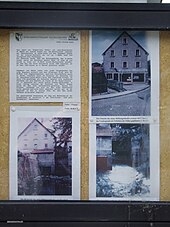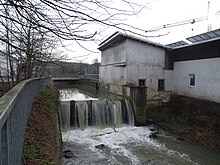Ziegler mill
The Ziegler'sche Mühle was a saw and grinding mill in the Baden-Württemberg community of Eschelbronn in the Rhein-Neckar district . The mill complex was from 1668 to the bridge at Schwarzenbach and led both multiple controversial because of contractual and legal disputes between the operators and the community, as well as to recurrent, caused by their location floods. It was demolished in 1985. Today there is a place of remembrance with a water wheel and an information board.
The mill is the birthplace of the missionary Georg Ziegler , who worked in China .
history
The cutting and sawmill was built by the sawmill Hans Rudolf on a community-owned property. The construction of the mill was subject to approval and linked to detailed requirements. After his death, the plant was taken over by the buyer Hans Wolf at the end of the 17th century.
Assuming that he was also the landowner , Wolf planned a residential building next to the facility on the opposite side of the Schwarzbach, but did not receive a building permit from the municipality because only the facility, not the property, was the subject of the purchase agreement. In addition, arguments against the construction would be that agricultural carts and timber transport would be hindered and neighboring meadow owners would have to complain about damage already caused by the mill. An expansion of the plant is therefore not desired.
Wolf then turned to the Zentgraf Kaufmann of the Meckesheimer Zent , who asked the community for an opinion on this. The Eschelbronn mayor responded with a letter dated September 23, 1698. The central court of the Meckesheimer Zent, to which the mayors from Meckesheim , Zuzenhausen , Gaiberg , Spechbach , Waldwimmersbach and Eschelbronn belonged, confirmed on October 23, 1698 the community's negative attitude towards the building. Since cattle should also be kept at the house, the vineyards on the southern slope of the Kallenberg are also endangered by the project.
In 1710, Wolf initially acquired 23 rods from private ownership (for 45 kreuzers per rod) on the Kirchwiesen corridor to build a new mill ditch and in 1722 received approval from the municipality to build a hemp grater and an oil mill. His son, the lawyer Johann Friedrich Wolf, also intended to build a grinding mill, which initially failed due to the resistance of the adjacent miller Hans Georg Schuhmann .
After Johann Friedrich Wolf had been elected mayor of Eschelbronn around 1738, he built a grain mill on the area next to the hemp grater and the oil mill without the permission of the mayor's office and with the sole support of the then local lord Count von Schönborn. The local council then filed a complaint with the Palatinate Office of Dilsberg against Mayor Wolf. According to the judgment of June 4, 1738, which was delivered to Wolf on June 24, the latter had to stop operating the grinding mill and expect the building to be demolished. However, the Vogtsherrschaft complained against the judgment.
In the following year, the community turned to the Dilsberg office and demanded that Wolf be deposed as mayor and that his legal rights be withdrawn. Wolf was accused of chopping wood for his own use in the forest and letting his cattle graze there, ruining the meadow valley and drilling into the village well, which would have resulted in a water failure. Three years later, the grinding mill was torn down and Wolf was no longer re-elected. The sawmill continued to operate.
On January 12, 1745, Wolf again submitted an application to the Palatinate Elector to build a grinding mill in Eschelbronn. After the application in Eschelbronn became known, 37 citizens wrote to the Dilsberg office on June 7, 1745 and informed them of their fear that the construction of a flour mill could damm up the Schwarzbach in heavy rain and cause flooding. Since Wolf refused to reimburse the community for the court costs and no longer paid the basic interest, the Eschelbronn and Spechbach mayors and three other people broke into his house in late 1745 and sealed the fruit store. Wolf wrote to the elector on July 7, 1746, "that an imminent, rich harvest would reduce the fruit price of the confiscated grain". According to a decision by the Dilsberg Office, the stolen goods were auctioned on July 16, 1746.
Wolf later worked as a master miller at the Pfeilschen Mühle in Heidelberg and sold the Eschelbronn plant for 225 guilders to Conrad Schuhmann from the neighboring municipality of Zuzenhausen . The legal dispute with Johann Friedrich Wolf ended on March 12, 1756 with a settlement at the expense of Wolf. In 1755 the mill was sold again to Johann Philipp Schüler from Zell near Michelstadt . Schüler intended to build a paper mill, but this was not approved, as two paper mills with guaranteed exclusive rights were already active in Neustadt an der Haardt and Wald-Michelbach in the Electoral Palatinate . Later the sawmill Christoph Filsinger was the operator of the plant, who sold it to Georg Michael Schuhmann on December 27, 1804. Schuhmann operated the property until 1838 and then sold it to Georg Ziegler from Neidenstein.
There were recurring disputes between the municipality and the respective mill operators, as the latter assumed that they had acquired the property with the purchase of the plant, while the municipality claimed the opposite and demanded land interest. According to a certificate from counselor Dinkel, from which it emerged that Ziegler had paid land interest and capital to the municipal treasury, the latter apparently appears to have been entered in the land register as the landowner, which ultimately resolved the ongoing dispute over the ownership of the area.
The son Martin Ziegler, father of the missionary Georg Ziegler , who later worked in China , also intended to build a grinding mill, like the previous owners of the mill. On April 5, 1871, he was initially informed in this regard by the Sinsheim district office : “The local council fears that greater use will be made of hydropower as the business grows. Furthermore, there is no need for a second mill and so the council hopes with certainty that the approval of Martin Ziegler will be refused. ”On September 17, 1871, however, the community concluded a contract with Ziegler that would allow him to build and water the meadows entitled. In return, Ziegler was obliged to cut wood for the citizens, to maintain the wooden bridge over the Schwarzbach and to maintain the water level. The construction of a residential house on the opposite side of the stream was finally made possible after the previous owner's requirement to live within the village no longer existed.
The construction of the mill reduced the water passage of the Schwarzbach. Larger water masses with persistent heavy rain or snowmelt were not taken into account, which led to multiple floods and flooding of the Eschelbronn town center. After the Second World War , the grinding mill lost its importance due to new large mills and increasing industrialization and was converted into a furniture store. In 1985 the property was bought by the municipality of Eschelbronn, the house on the bank was torn down and the water flow tripled to twelve meters in width to prevent further flooding.
The adjacent sawmill is still in operation and is still owned by the Ziegler family, now in the sixth generation.
Others
In 1993, a picture of the mill served as a motif for the Christmas mugs from the "Old Views" series, which have been produced annually since 1992 for the Eschelbronn Advent Singing.
Web links
literature
- Wilfried Wolf: The cutting, sawing and grinding mill on the Schwarzbach (Zieglersche Mühle) in 1200 years of Eschelbronn 789–1989 , page 46 ff.
- Heimat und Verkehrsverein Eschelbronn (publisher): The Sägmühle in Eschelbronn Your home , page 100 ff.
Individual evidence
- ↑ Ziegler sawmill at eschelbronn-online.de
- ↑ Advent Singing , Eschelbronn Local History and Tourist Association
Coordinates: 49 ° 19 '22.2 " N , 8 ° 52' 8.4" E




